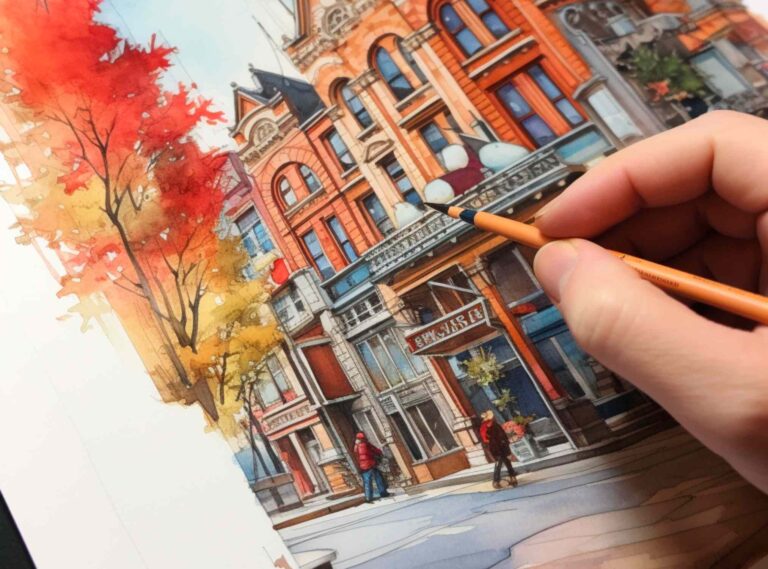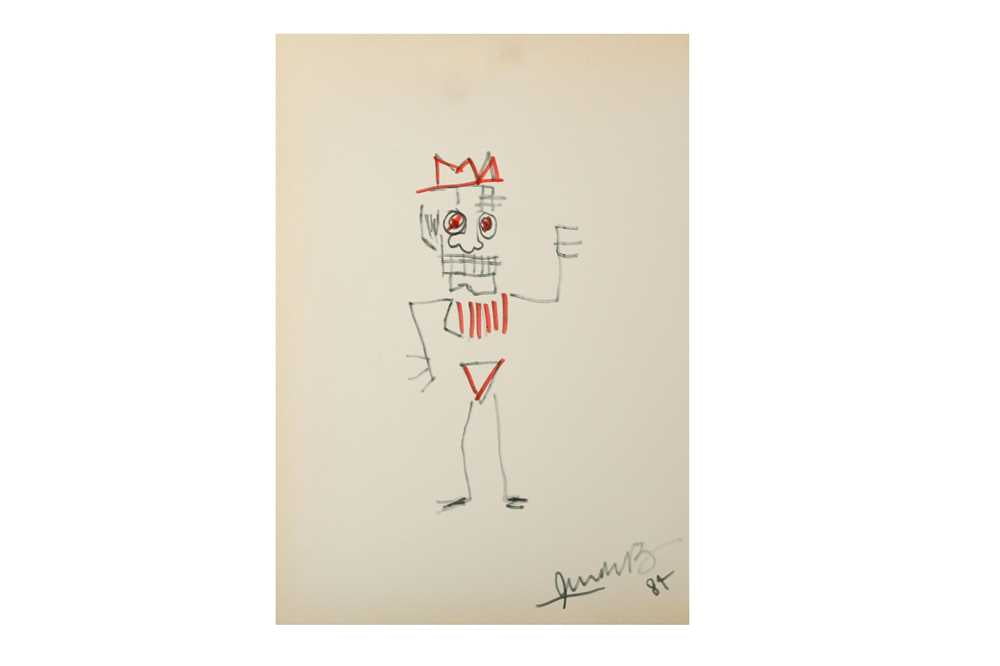Last Updated on July 3, 2023 by Dee
When it comes to signing your artwork, there are a few things to keep in mind to ensure that your signature is both professional and effective. As an artist, your signature is not only a way to identify your work but also a way to add value to it. A well-placed and well-executed signature can increase the value of your artwork and make it more desirable to collectors.
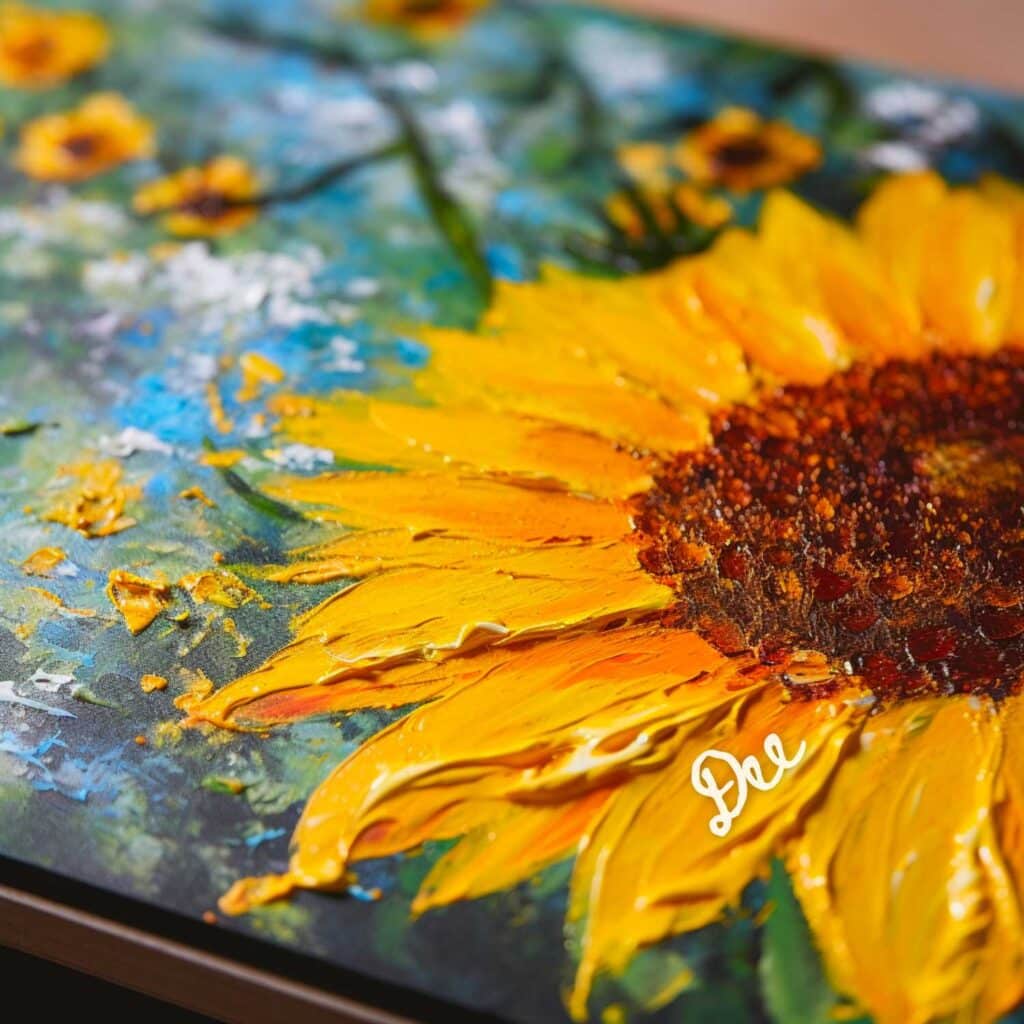
One of the first things to consider when signing your artwork is where to place your signature. Some artists prefer to sign their work in a specific location, such as the bottom right corner, while others prefer to incorporate their signature into the piece itself. If you’re not sure where to sign your artwork, consider signing a piece of transparent paper and placing it over your artwork to see how it looks in different locations. You can also experiment with different styles and sizes of signatures to find what works best for you and your artwork.
So many people wonder about whether or not they should sign their artwork. What are the ‘rules’ for signing your art? Since the beginning of the Renaissance, artists have questioned whether they should sign their artworks.
Some artists like Leonardo DaVinci didn’t sign their artworks, as they often worked collaboratively. Basquiat’s signature is very well known but can be quite illegible at times. Picasso signed his art with the initials P.R (Picasso Ruiz) in his early works, but later he dropped the ‘R’ and signed a new, decorative version of ‘Picasso’.
Let’s go through the conventions in signing your artwork, and what the best practice is today.
Why should you sign your artwork?
Putting your signature on your artwork is important in establishing you as the legitimate creator of the work.
Now more than ever we live in a society where digital reproduction and art forgery, and plagiarism can easily happen. Although signing your artwork doesn’t completely prevent someone from stealing your image it does make it more difficult for them.
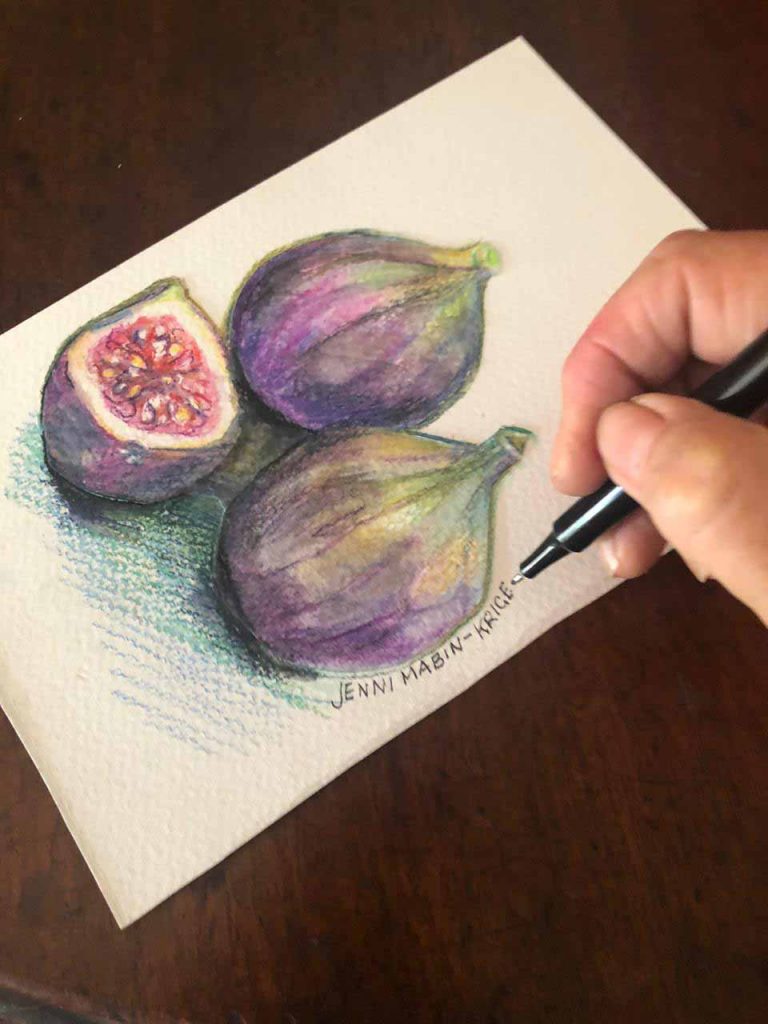
Your signature becomes part of your brand identity of your art business in the art world. The more of your artwork people see, the more they will associate your signature with you.
It is also important to note that the signature on an artwork suggests that the artwork is complete.
Understanding the Importance of Signing Artwork
As an artist, you put your heart and soul into each piece you create. Signing your artwork is a crucial step that shouldn’t be overlooked. Here’s why:
Value
Signing your artwork can increase its value significantly. It shows that you take pride in your work and are confident in its quality. Additionally, signed artwork is more likely to be considered genuine and authentic, which can make it more desirable to collectors and buyers.
Identify
Your signature is a way to identify your artwork and distinguish it from others. It can help people recognize your unique style and remember your name. This is especially important if you plan on selling your artwork or exhibiting it in galleries.
Artist Signature
Your signature is also a representation of you as an artist. It’s an opportunity to showcase your personality and creativity. Consider incorporating your signature into your artwork in a way that’s both aesthetically pleasing and consistent.
Signatures
When signing your artwork, it’s important to do so in a way that’s legible and consistent. This helps people identify your work and makes it easier to track down other pieces you’ve created. Consider using a specific signature style or font that you use consistently across all of your artwork.
Sign Your Art
Don’t be afraid to sign your art! Whether you’re a beginner or a seasoned professional, signing your artwork is an important step that shouldn’t be overlooked. It shows that you take pride in your work and are confident in its quality.
Signing Your Art
When signing your art, consider doing so in a location that’s visible and won’t detract from the overall piece. Avoid signing in a way that covers up important elements of the artwork. Additionally, consider using a signature that’s in contrast to the colors of the artwork to make it more visible.
Consistent Signature
How should you sign your artworks?
Many artists in the past and today have used monograms. These are essentially a motif of two or more interwoven letters, typically a person’s initials. This can almost be viewed as the artist’s logo.
If you are starting off with creating art, and figuring out which signature to use, I would suggest not going this route. By using a monogram, viewers cannot establish what your full name or even your surname is. However, if you have envisioned this monogram as part of your identity and are dead set on it, make sure to write your full name and details at the back of the artwork.
Recently I attended a local informal art exhibition and came across a beautiful landscape painting. The artist had only written their initials ‘R.J’ on the bottom of the painting, and there was no other nearby information on who they might be.
To be fair this was an unusual occurrence. Any professional art exhibition would have had the name of the artist, and the details of the piece on display for viewers to see.
Include your first name and surname, or even just your surname in your signature.
Date your artwork. This becomes an important reference when you look back over your art-making history. You will get a sense of how your art has developed over time.
Make it easy for people to see your name easily when they look at your artwork.
That brings me to my second point. You don’t have to have font-like handwriting to sign your painting, but you really should try to make it legible. Once again, if the viewer can’t read the name on a painting they may not come back to look for the artist’s other work.
Make your signature consistent. Try to keep it the same on each of your artworks as this will, once again, help people to recognize who the painting is by.
Your signature should be visible and clear, but not so much so that it detracts from the painting. A good idea is to sign in the same medium as your artwork. So, if you have painted in acrylic paint, sign in acrylic. By signing in the same medium, people won’t question whether the artwork is yours or not.
Artists often scratch their names into the wet acrylic painting (or oil painting) if they have painted thickly onto the canvas. In this way, their names become part of the artwork and cannot easily be removed or altered.
When I sign my paintings, I often use a slightly darker or lighter tone of the main color in my artwork. By doing this my signature fits in with the aesthetic of my piece and doesn’t stand out like a sore thumb.
When signing a watercolor painting, you can sign in lead pencil or in watercolor paint. Some watercolorists I know, write their signatures in a fine liner of a similar color to their subject matter.
When it comes to art prints, an artist has to sign their name and record the edition of the print as well as the date. This is usually done in lead pencil as is the standard convention.
Write the details of your painting or drawing on the back of the paper or canvas. Write your full name, the date, the medium, and the title of your piece. This is especially important if you have not signed your full name on the front of your artwork.
Choosing the Right Signature
When it comes to signing your artwork, there are a few different options to consider. Your signature should be unique and recognizable, and it should clearly identify you as the creator of the piece. Here are a few things to keep in mind when choosing the right signature for your artwork.
Using Full Name or Initials
One option is to sign your artwork with your full name or initials. If you choose to use your full name, make sure it is legible and easy to read. You can also use your first and last name, or just your last name. If you choose to use your initials, make sure they are clear and easy to identify. Avoid using a monogram or initials that are too similar to other artists’ signatures.
Creating a Unique Monogram or Logo
Another option is to create a unique monogram or logo for your artwork. This can be a great way to brand yourself as an artist and make your work more recognizable. Your monogram or logo should be simple, yet distinctive, and it should be easy to reproduce on all of your artwork. You can use your initials or a symbol that represents your style or subject matter.
Maintaining a Consistent Signature
No matter what signature you choose, it is important to maintain consistency across all of your artwork. This will help build recognition for your work and make it easier for collectors and buyers to identify your pieces. Make sure your signature is placed in the same location on each piece, and use the same style and size for each signature. If you change your signature, make sure to update all of your existing artwork as well.
Ultimately, the signature you choose for your artwork should be a reflection of your personal style and brand as an artist. Take the time to experiment with different options and find the one that feels right for you. With a little practice and consistency, your signature can become an integral part of your artwork and help you build a successful career as an artist.
Selecting the Appropriate Medium for Signature
When it comes to signing your artwork, it’s important to choose the right medium to ensure that your signature is both legible and long-lasting. Here are some options to consider:
Ink and Graphite
Ink and graphite are great options for signing works on paper. You can use a pen or pencil to create a signature that is both legible and subtle. Be sure to choose a pen or pencil that won’t smudge or bleed over time, as this can compromise the integrity of your signature.
Oil Paint and Acrylic Paint
If you’re working with oil or acrylic paint, you can sign your artwork with a brush or palette knife. This will create a signature that is integrated into the painting itself. Be sure to use a contrasting color to your oil painting so that your signature stands out, and consider varnishing over it to protect it from fading or cracking over time.
Archival Pen and Sharpie
Archival pens and Sharpies are great options for signing works on paper or canvas. They come in a variety of colors and tip sizes, so you can choose the one that best suits your needs. Be sure to choose a pen or Sharpie that is labeled as archival, as this means that it is designed to last for a long time without fading or smudging.
Acrylic Markers
Acrylic markers are a great option for signing works on canvas or other non-porous surfaces. They come in a variety of colors and tip sizes, so you can choose the one that best suits your needs. Be sure to choose a marker that is labeled as archival, as this means that it is designed to last for a long time without fading or smudging.
No matter which medium you choose, be sure to practice your art signature beforehand to ensure that it is both legible and consistent. And remember to sign your artwork in a place that won’t detract from the piece itself, such as the bottom right corner.
Deciding the Location of Signature – Where should you sign?
Most artists sign either on the artwork’s bottom left- or right-hand side. Try to sign a couple of inches away from the edge of the canvas or page to compensate for the framing of the piece.
Take time to consider where you are going to sign your artwork carefully. Your signature doesn’t necessarily have to be in the bottom right-hand corner on a straight line. You can sign your name up the trunk of your painted tree, or alongside another form in your subject matter.
Once again, ensure that your signature fits harmoniously with the artwork. It is also important to remember that most people will look at the artwork’s bottom left- or right-hand side to see who the artist is. If your signature is placed somewhere obscure, they may not see it.
As an artist, deciding where to sign your artwork can be a personal choice. However, there are some best practices to consider when making this decision. Two common locations for signatures are the bottom corner and the lower right-hand corner.
Bottom Corner
Traditionally, many artists sign their work in one of the bottom corners. This is often the first place that a collector will look for a signature. It is important to sign on the artwork itself and not on the mat or stretcher bar. If you choose to sign in the bottom corner, consider the following tips:
- Sign in a contrasting color to the artwork so that it is easily visible.
- Use a signature that is legible and consistent.
- Sign your full name or initials, depending on your preference.
Lower Right-Hand Corner
Another popular location for signatures is the lower right-hand corner. This location is also easily visible to collectors and allows for a larger signature. If you choose to sign in the lower right-hand corner, consider the following tips:
- Sign in a contrasting color to the artwork so that it is easily visible.
- Use a signature that is legible and consistent.
- Sign your full name or initials, depending on your preference.
Ultimately, the decision of where to sign your artwork is up to you. Consider your personal style and preferences when making this decision. Just remember to sign on the artwork itself and not on the mat or stretcher bar.
Ensuring Legibility of Signature
When signing your artwork, it is essential to make sure that your signature is legible. A illegible or hard-to-read signature can detract from the overall presentation of your artwork and make it difficult for collectors to identify and appreciate your work. Here are a few tips to ensure that your signature is easy to read:
- Choose a clear signature style: Your signature should be clear and easy to read. Choose a signature style that is simple and easy to write, and avoid using overly elaborate or complicated signatures. This will help ensure that your signature is legible and easy to read.
- Sign in a visible location: When signing your artwork, make sure to sign in a visible location that is easy to see. Avoid signing in a corner or other inconspicuous location, as this can make it difficult for collectors to identify your work.
- Use a contrasting color: To make your signature stand out, use a contrasting color that is easy to see against the background of your artwork. For example, use a light-colored pen or marker for your signature if your artwork is predominantly dark, and vice versa.
- Practice your signature: Before signing your artwork, practice your signature to ensure that it is clear and easy to read. This will help ensure that your signature is consistent and legible across all of your artwork.
By following these tips, you can ensure that your signature is legible and easy to read, helping to enhance the overall presentation of your artwork and making it easier for collectors to appreciate and identify your work.
Incorporating the Year and Size of Artwork
When signing your artwork, you may want to consider incorporating the year and size of the piece. This can be helpful for both you and potential buyers, as it provides important information about the artwork.
Including the Year
Adding the year to your signature can be a helpful way to keep track of your artwork over time. It can also be useful for potential buyers who want to know when the piece was created. When including the year, there are a few different ways you can do it:
- Write the full year (e.g. “2023”)
- Use just the last two digits of the year (e.g. “23”)
- Write the year in Roman numerals (e.g. “MMXXIII”)
Choose the method that works best for you and your signature style. Just make sure that the year is legible and easy to read.
Including the Size
Including the size of the artwork can also be helpful for potential buyers. It gives them an idea of how large or small the piece is, which can be important when considering where to display it. When including the size, you can do it in a few different ways:
- Write the dimensions in inches or centimeters (e.g. “16×20” or “40x50cm”)
- Use the diagonal measurement (e.g. “24-inch diagonal”)
Again, choose the method that works best for you and your signature style. Just make sure that the size is clear and easy to read.
Incorporating the year and size into your signature can be a helpful way to provide important information about your artwork. It can also give your signature a more professional and polished look. Experiment with different ways of including this information to find what works best for you.
Signature and Framing
When it comes to signing your artwork, it’s important to consider the framing process. The way you sign your art can be affected by the framing choices you make. Here are some things to keep in mind when it comes to signature and framing.
Framed Artwork
If you plan on framing your artwork, you may want to consider signing it on the back of the piece. This is because the signature can be covered by the frame, especially if the artwork is matted. However, if you prefer to sign your artwork on the front, make sure to leave enough space around the edges to accommodate the frame.
Mat
If you plan on using a mat for your artwork, make sure to sign the piece before matting it. This way, the signature won’t be covered by the mat. You can also choose to sign the mat itself, but keep in mind that the mat can be replaced or removed, so it’s best to sign the artwork itself.
Varnish
If you plan on varnishing your artwork, make sure to sign it before applying the varnish. This is because the varnish can alter the appearance of the signature, making it harder to read. You can also choose to sign the varnish itself, but remember that it can be removed or replaced, so it’s best to sign the artwork itself.
In conclusion, when it comes to signature and framing, it’s important to consider the framing process and make sure the signature is visible and won’t be covered by the frame or mat. Sign the artwork before matting or varnishing it to ensure the signature remains legible.
Taking Inspiration from Famous Artists
Looking at the signature styles of famous artists can be a great source of inspiration when it comes to signing your own artwork. By studying their techniques and signature styles, you can develop your own unique signature that reflects your personality and style.
One famous artist whose signature is instantly recognizable is Vincent van Gogh. His signature is bold and expressive, with large letters that are almost illegible. If you want to create a signature that is similar to van Gogh’s, try using a thick marker or brush pen to create large, expressive letters.
Another artist whose signature is famous is Pablo Picasso. Picasso’s signature is simple and elegant, with flowing lines and a cursive style. If you want to create a signature that is similar to Picasso’s, try using a fine-tipped pen or brush to create flowing, elegant lines.
Claude Monet is another artist whose signature is famous for its elegance and simplicity. His signature is small and unobtrusive, with delicate lines that are almost like calligraphy. If you want to create a signature that is similar to Monet’s, try using a fine-tipped pen or brush to create delicate, flowing lines.
In addition to studying the signature styles of famous artists, you can also take inspiration from their artwork itself. Look at the colors, composition, and overall style of their work, and try to incorporate elements of their style into your own artwork and signature.
Remember, your signature is a reflection of your personality and style as an artist. By studying the techniques and styles of famous artists, you can develop your own unique signature that is both expressive and reflective of your artistic vision.
When should you not sign the piece?
If you have copied someone else’s painting it is considered plagiarism if you sign your name. You are essentially passing off the image as your own. On the back of a painting you have copied, you should always cite the original artist’s name and date.
Perhaps you would like to read more of my articles on artist tips and tricks like Painting on an Easel…
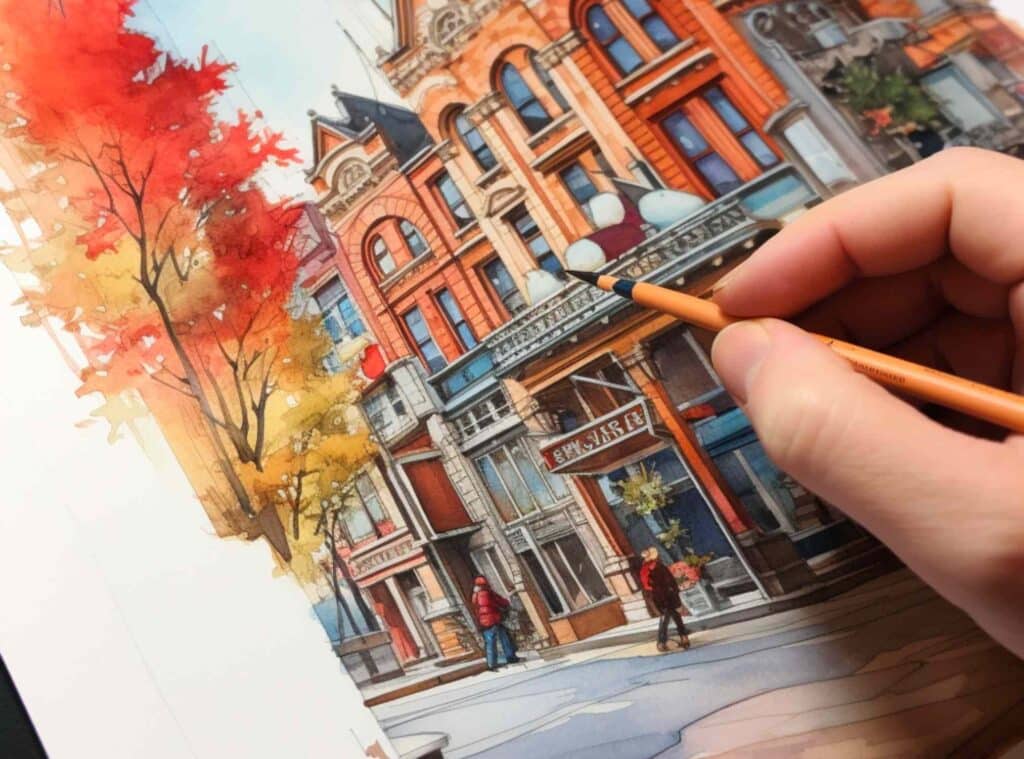
Frequently Asked Questions
Where should I place my signature on a painting?
You can place your signature in a variety of locations on a painting, including the bottom right or left corner, the back of the canvas, or on the front of the painting in a subtle location that does not detract from the artwork itself. Ultimately, the placement is up to your personal preference and style.
What is the best pen for signing artwork?
When signing artwork, it’s important to use a pen that is archival quality and will not fade or smudge over time. Look for pens that are labeled as “archival” or “acid-free” to ensure the longevity of your signature. Some popular options include Micron pens, Sakura Pigma pens, and Faber-Castell pens.
How do I create a signature for my artwork?
Creating a signature for your artwork can be as simple as using your name in a unique and stylized way. Experiment with different fonts and handwriting styles until you find one that you like. It’s important to ensure that your signature is legible and consistent across all of your artwork.
Should I sign the back of a canvas painting?
Signing the back of a canvas painting is a common practice among artists, as it allows for additional information such as the title, date, and medium to be included. However, it is not necessary to sign the back if you prefer to sign the front of the painting.
How do you sign your signature on a painting?
When signing your signature on a painting, use a steady hand and take your time to ensure that the signature is legible and consistent. Some artists prefer to use a stylized version of their name, while others use a monogram or symbol. Experiment with different styles until you find one that you are happy with.
How do artists typically sign their prints?
When signing prints, artists often use a pencil or pen to sign the bottom margin of the print. Some artists also include additional information such as the title, edition number, and date. It’s important to use archival-quality materials to ensure that the signature does not fade or smudge over time.
Other articles you may enjoy…
[11 Ways to Improve Your Drawing]
[Sitting Drawing Reference | 18 Free Poses to Use for Figure Drawing]
[101 Cool Designs to Draw | Easy Ideas for Drawing Fun]
[An Easy Guide on How to Change the Opacity of a Layer in Procreate]

